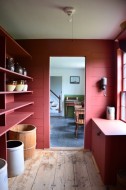.jpg)
The Cottage (part 1)
July 31, 2019
We celebrated the start of summer with the completion of our latest project; a kitchen/pantry renovation in a 100+ year old cottage, in the sleepy Calais suburb of Red Beach. Situated on the St. Croix River around a sheltered cove and first-rate mill stream, one would never suspect driving through this quiet residential district today, that it was once a vibrant, prosperous, self-sufficient community. In the 19th century the thriving village sported a plaster mill, granite mill, grist mill, cooperage, company store, post office, and other related industry, as well as, a bustling deep-water harbor.
Exploiting the cove's natural resources,The Red Beach Plaster Company was organized in 1846 to produce calcinated plaster, a construction material. Plaster rock from quarries in Nova Scotia and New Brunswick was processed at the mill, then packed in paper lined barrels constructed at the cooperage. The finished product was shipped along the Atlantic Coast for the building industry to help meet the need for new structures in a rapidly growing country.
In 1875, having located large veins of red granite on their property, management founded a subsidiary, the Maine Red Granite Company. Large slabs from 3 quarries were pulled by horse or oxen on sleds or flat-bed wagons, to polishing works upstream from the plaster mill. There it was shaped and polished to a high gloss finish, producing beautiful columns, pilasters, tombstones, and ornamental pieces.
It can be found on many important buildings and monuments around the country including; the Frances Scott Key monument in Fredrick, Maryland, the county building and post office in Lima, Ohio, the courthouse at Marquette, Michigan, the Museum of Natural History in New York City, Baptist churches in New Hampshire and Virginia, - columns for the courthouse at Providence, R.I., the customhouse in Kansas City, Missouri, the Centennial Block in Portland, Maine - and the plant cases on the terrace around the United States Capitol.
Many in town were employed by these mills or quarries nearby. There were quarrymen, granite polishers, stone cutters, plaster smiths and coopers, as well as, sea captains, sailors and dockworkers, manning or loading coastal vessels that carried their products to market. By the turn of the 20th century, plagued by financial problems and decreasing demand, the industry began to decline; suffering its death knell in 1926, when a conflagration of unknown origin leveled the entire complex at Red Beach Cove.
The compact cottage is situated just downriver from the cove on a river bank overlooking a small brook that empties into Huckins Cove. It boasts stunning views of the cove, river, Canada and St.Croix Island. The historic island, known by locals as Dochet or Bone Island, was the site of the first attempt at Acadian colonization by the French monarchy.
In 1604, predating Jamestown by 3 years, merchant/explorer, Pierre Dugua, Sieur de Mons, accompanied by the noted cartographer, Samuel de Champlain, mounted a daring expedition to the 'New World'. Together with a company of noblemen, artisans, soldiers, a surgeon, a Huguenot minister and a Roman Catholic priest, they established a trading settlement on the island they christened, Îsle de sainte-Croix [Isle of the Holy Cross].
Structures were constructed, a mill built at the cove, gardens planted and stores secured in anticipation of the coming cold weather. Unprepared for the severity of the unusually harsh Maine winter and cut off from fresh water and game by perilous ice flows - tragedy ensued. 35 men, nearly half the contingent of 79, died of scurvy before the advent of spring could provide relief. All remain buried on the island.
The triangle of land on which our project home stands, was at one time part of a 100-acre farm established around 1850, by Daniel and Ester Huckins. It first appears in the record in 1916, when it was separated from the larger property as “a certain parcel of land with the cottage thereon,” and deeded to Mary Gray of Calais. She and her husband, Robert, a grocery clerk, very likely purchased the property as a summer retreat.
This was a period when summer cottages or “camps” were sprouting up and down the river and around local lakes; popularized, in part, by the writings of Henry David Thoreau (Walden/The Maine Woods), and the growing Rusticator Movement. Beginning in the second half of the 19th century, tourists would come from Boston or New York City by stage coach or rail to participate in the vigor and clean living of the wilderness experience.
In our area local men would act as guides for visiting sportsmen. Families from nearby towns like Calais and Eastport would often spend whole summers, seeking relief from heavy industry, in the peace and tranquility of a country cabin.
Click here for Part 2
Thanks to the Southwest Harbor Public Library and the St.Croix Historical Society.
(click photo to view larger image)
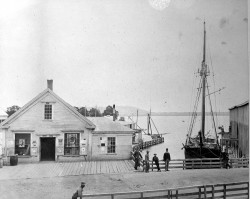
|
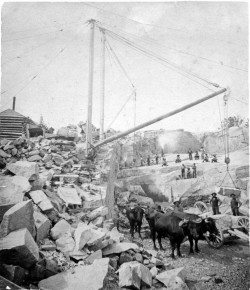
|
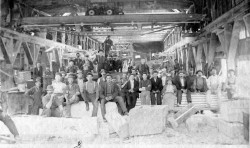
|
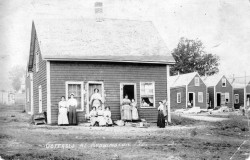
|
(comments = 0)
leave a comment

fineartistmade blog
A journal about home design, gardening, art & all things Maine. Read more...
- June 2025
- December 2022
- November 2022
- October 2022
- November 2021
- May 2020
- October 2019
- August 2019
- July 2019
- September 2018
- April 2018
- December 2017
- August 2017
- June 2017
- May 2017
- December 2016
- August 2016
- July 2016
- April 2016
- November 2015
- June 2015
- May 2015
- March 2015
- October 2014
- March 2014
- February 2014
- January 2014
- December 2013
- November 2013
- July 2013
- May 2013
- April 2013
- March 2013
- January 2013
- December 2012
- November 2012
- August 2012
- June 2012
- April 2012
- March 2012
- February 2012
- January 2012
- December 2011
- October 2011
- August 2011
- July 2011
- June 2011
- May 2011
- April 2011
- March 2011
- February 2011
- January 2011
- December 2010
- November 2010
- October 2010
- September 2010
- August 2010
- July 2010
- June 2010
- May 2010
- My Scandinavian Home
- Daytonian in Manhattan
- {frolic!}
- I Married An Irish Farmer
- Smitten Kitchen
- The Curated House
- even*cleveland
- Mary Swenson | a scrapbook
- Ill Seen, Ill Said
- Gross & Daley Photography
- Remodelista
- Abby Goes Design Scouting
- Mint
- the marion house book
- 3191 Miles Apart
- Svatava
- Katy Elliott
- Poppytalk
- Kiosk
- decor8
- KBCULTURE
- Lari Washburn


